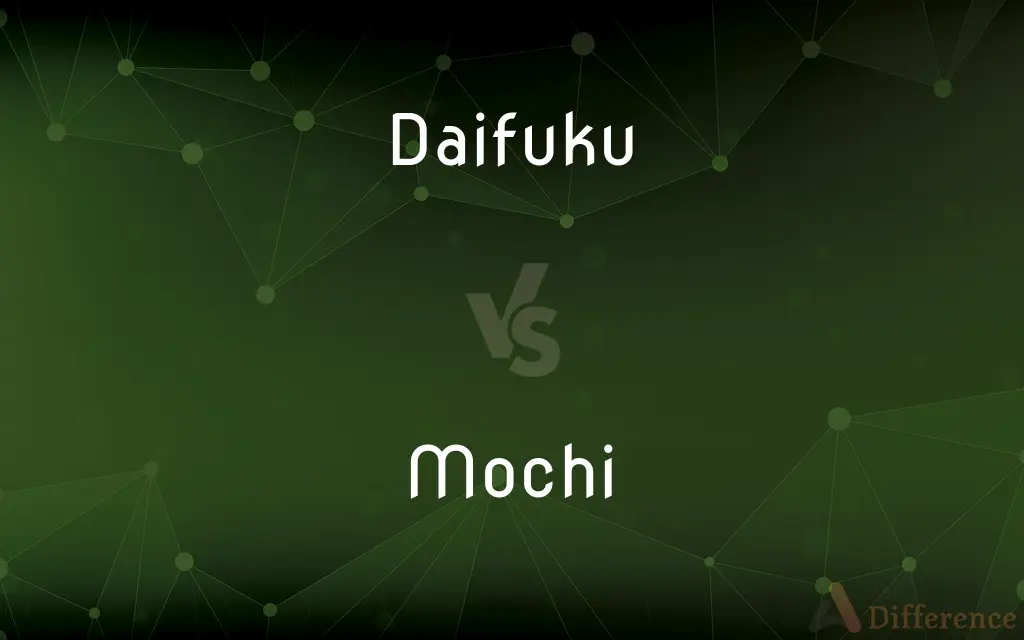Daifuku vs. Mochi — What's the Difference?
By Maham Liaqat & Fiza Rafique — Updated on April 19, 2024
Daifuku is a sweet Japanese confection consisting of mochi stuffed with fillings like red bean paste, while mochi is a versatile rice cake made from glutinous rice, enjoyed in various forms and flavors.

Difference Between Daifuku and Mochi
Table of Contents
ADVERTISEMENT
Key Differences
Daifuku is a specific type of Japanese mochi that is known for its filling, typically anko (sweet red bean paste), which is encased in a soft, chewy mochi shell. This confection is a popular treat in Japan, often enjoyed as a dessert or a snack. Whereas mochi, on the other hand, refers broadly to Japanese rice cakes made from glutinous rice pounded into a paste and molded into shape. Mochi can be sweet or savory, and is used in a variety of dishes, from soups to desserts.
The preparation of daifuku involves wrapping the sweet or savory filling with mochi, creating a distinct confection that combines the chewiness of mochi with the flavor of the filling. While mochi itself is versatile in its usage, serving as a base for various traditional Japanese dishes such as ozoni (a New Year’s soup) and can be flavored or colored differently.
Daifuku often features additional ingredients that enhance its taste and texture, such as powdered soybean flour (kinako), which adds a nutty flavor, or a whole strawberry, creating a popular variation known as ichigo daifuku. In contrast, plain mochi may be eaten without additional ingredients, emphasizing the subtle sweetness and texture of the glutinous rice.
In terms of texture, daifuku is typically softer and more pliable due to the moisture from its fillings, which contrasts with the more variable texture of plain mochi, which can range from soft and sticky to firmer, depending on its preparation and intended use.
Culturally, daifuku is often associated with special occasions and seasonal celebrations, symbolizing good fortune and happiness. Mochi, however, has a deeper cultural significance in Japan, being an essential part of New Year festivities and other traditional rituals, symbolizing long life and well-being.
ADVERTISEMENT
Comparison Chart
Definition
A sweet mochi confection with a filling
A versatile Japanese rice cake
Primary Use
Dessert or snack
Used in various dishes, both sweet and savory
Texture
Soft and pliable
Ranges from soft to firm
Cultural Significance
Often enjoyed during special occasions
Integral to various Japanese traditions
Varieties
Includes fillings like red bean, strawberry
Plain or mixed with ingredients like bean paste
Compare with Definitions
Daifuku
A confection known for its chewy texture and sweet fillings.
Daifuku comes in many varieties, including some filled with whole strawberries.
Mochi
Integral to various Japanese rituals and celebrations.
Mochi is used in both culinary and ceremonial contexts in Japan.
Daifuku
A Japanese sweet mochi with a filling, often anko.
She brought a box of daifuku, with each piece delicately dusted with rice flour.
Mochi
Can be sweet or savory, depending on additions.
Sweet mochi is often filled with red bean paste.
Daifuku
Can be coated with kinako or matcha for additional flavor.
He prefers his daifuku dusted with kinako for its earthy sweetness.
Mochi
Known for its sticky, chewy texture.
Making mochi involves a lot of pounding to achieve its chewy texture.
Daifuku
Often enjoyed as a dessert or seasonal treat in Japan.
During the flower viewing season, many enjoy strawberry daifuku as a picnic snack.
Mochi
Consumed year-round, but especially during the New Year.
For New Year, it is customary to prepare zoni soup with mochi.
Daifuku
Symbolizes happiness and fortune in Japanese culture.
They served daifuku at their wedding as a symbol of their shared happiness.
Mochi
Mochi (餅•もち, lit. 'glutinous rice cake') is a Japanese rice cake made of mochigome, a short-grain japonica glutinous rice, and sometimes other ingredients such as water, sugar, and cornstarch. The rice is pounded into paste and molded into the desired shape.
Daifuku
Daifukumochi (大福餅), or daifuku (大福) (literally "great luck"), is a wagashi, (a type of Japanese confection) consisting of a small round mochi (a glutinous rice cake) stuffed with a sweet filling, most commonly anko, (a sweetened red bean paste made from azuki beans). Daifuku is a popular wagashi in Japan and is often served with green tea.
Mochi
Cooked sticky rice pounded into a paste, formed into balls or cakes, and used to make sweets and savory dishes in Japanese cuisine.
Daifuku
A Japanese dessert consisting of a large mochi stuffed with red bean paste.
Mochi
A cake formed from such paste.
Mochi
The variety of short-grain rice, having a sticky, glutinous consistency when cooked, used to make mochi. Also called mochi rice.
Mochi
A Japanese rice cake made from glutinous rice.
Common Curiosities
What are common fillings for daifuku besides red bean paste?
Common fillings include white bean paste, strawberry, and matcha-flavored cream.
What is the best way to store daifuku?
Daifuku is best stored in an airtight container at room temperature for a few days or refrigerated if it contains perishable fillings.
How is daifuku different from other mochi desserts?
Daifuku is specifically known for its filling, while other mochi desserts may be plain or only slightly sweetened.
What is the cultural significance of eating mochi during New Year’s in Japan?
Eating mochi during New Year’s is believed to bring health and good fortune for the upcoming year.
Can mochi be flavored with ingredients other than bean paste?
Absolutely, mochi can also be flavored with things like green tea, sesame, or even incorporated into ice cream.
How do you eat mochi safely?
Mochi should be eaten in small pieces and chewed thoroughly to prevent choking, as its sticky texture can be tricky to swallow.
Is daifuku suitable for vegetarians?
Generally, yes, as its main ingredients are plant-based, but it's always good to check for specific fillings like gelatin which some manufacturers might use.
Can mochi be used in meals other than desserts?
Yes, mochi is versatile and can be included in savory dishes like soups and even grilled as a side dish.
Are there any health benefits to eating mochi or daifuku?
Mochi is low in fat and can be a good energy source due to its high carbohydrate content; however, moderation is key due to its dense texture and caloric content.
Are there different textures of mochi?
Yes, mochi can vary from soft and pillowy to quite firm, depending on how it’s cooked and served.
How long does it take to make homemade mochi?
The traditional mochi-making process, mochitsuki, can take several hours, including the time to steam the rice and pound it into the desired consistency.
Can mochi be eaten cold?
Yes, mochi can be enjoyed cold, especially when it's used in desserts like ice cream mochi.
Does daifuku come in different sizes?
Yes, daifuku can range from bite-sized to larger, palm-sized versions, depending on the filling and the occasion for which they are made.
Is daifuku commonly found outside of Japan?
Yes, daifuku has become popular in various parts of the world, often found in Japanese specialty stores or regions with a significant Japanese population.
What precautions should be taken when making mochi at home?
Care should be taken to ensure the rice is thoroughly pounded to the right texture and that the hot ingredients are handled safely to avoid burns.
Share Your Discovery

Previous Comparison
Layer vs. Stratum
Next Comparison
Moan vs. MournAuthor Spotlight
Written by
Maham LiaqatCo-written by
Fiza RafiqueFiza Rafique is a skilled content writer at AskDifference.com, where she meticulously refines and enhances written pieces. Drawing from her vast editorial expertise, Fiza ensures clarity, accuracy, and precision in every article. Passionate about language, she continually seeks to elevate the quality of content for readers worldwide.














































